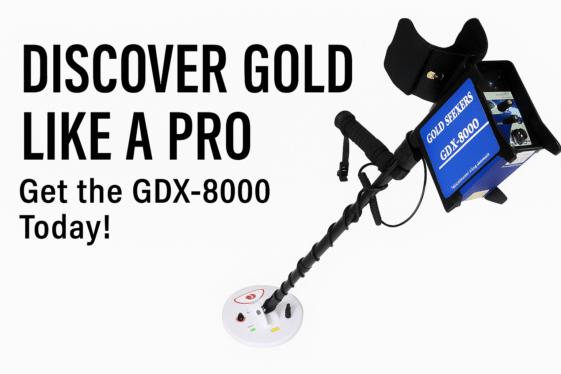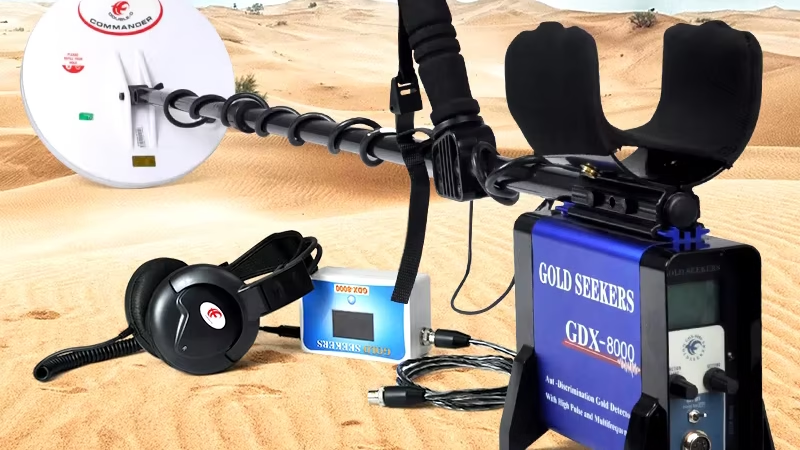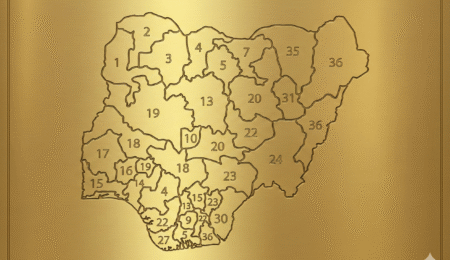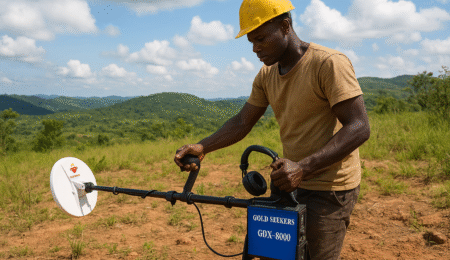1. Introduction
Zamfara remains one of Nigeria’s most active gold-bearing regions, especially across Anka, Bukkuyum, Gummi, Maru, and Malele. But unlike shallow placer environments found in parts of Niger and Osun, Zamfara’s gold is mostly trapped in hard, sulphide-rich quartz veins, deeply weathered schists, and structurally controlled shear zones.
For this reason, choosing the right gold detector is not optional, it directly determines whether a miner, cooperative, or prospecting team actually finds gold or wastes days scanning silent ground.
This guide breaks down:
- the true ground conditions in Zamfara,
- why many detectors fail here,
- what a detector must have to succeed,
- and why the GDX-8000 Gold Detector has become the most reliable tool in the field for serious prospectors.
Whether you’re a landowner, a small-scale miner, a registered cooperative, or a gold exploration scout working ahead of drilling teams, this is your practical roadmap.
🟡 Thinking of exploring for gold in Nigeria? Whether you’re a miner, landowner, or investor, the GDX-8000 Gold Detector is the trusted tool transforming local gold discovery across Nigeria and West Africa.
Detect deeper, find faster, and uncover real opportunities beneath your land.
👉 Order your Original GDX-8000 NOW – exclusively from the Nigerian Mineral Exchange (NME), Nigeria’s leading mining marketplace.
💬 Chat directly with our support team on WhatsApp: +234 8130799304
2. Ground Conditions in Zamfara
Zamfara’s gold belt is defined by complex geological environments, including:
✅ Highly Mineralised Soils
- Strong magnetic interference
- Rich in ironstones and sulphides
- Causes signal noise and false positives
✅ Deeply Weathered Profiles
- Gold rarely sits near the surface
- Targets are often 30–120 cm below laterite caps
✅ Hard Quartz Veins
- Common around shear zones in Anka–Maru
- Require detectors that can see through dense rock matrices
✅ Variable Conductivity
- Soil response can change within a few metres
- Cheap VLF detectors become unstable and unreliable
For Zamfara, complex ground mineralization, not terrain is the real challenge.
3. Challenges of Hard-Rock Gold Exploration
Unlike alluvial gold found in riverbeds, most Zamfara gold is host-rock controlled. This means:
❌ Surface scanning is rarely enough
Gold is locked inside quartz, not scattered across wash zones.
❌ Low-frequency detectors struggle
They can detect coins and scrap metal, but not deep-seated gold.
❌ Noise increases false targets
Prospectors waste time digging empty ground.
❌ Beginners underestimate depth
Gold in Zamfara is often beyond the reach of consumer-grade gold detectors.
This is why many miners and cooperatives who previously relied on trial-and-error now use detectors designed for hard-rock and sulphide environments, rather than hobby-grade equipment.
4. Detector Requirements for the Region
To succeed in Zamfara, a detector must check all the following boxes:
✅ Pulse-Induction (PI) Technology
- Filters out mineralised noise
- Maintains depth in iron-rich ground
✅ High Sensitivity to Small Nuggets
- Detects 0.1–0.3 g particles at depth
- Critical for early-stage scouting
✅ Deep Penetration Capability
Minimum performance threshold:
- 60–120 cm in compacted soils
- Up to 5 m in ideal conditions
✅ Ground Balancing for Variable Terrains
- Adaptive adjustment prevents signal fade
- Necessary when moving between:
- laterite ridges
- stream channels
- vein outcrops
✅ Rugged Field Durability
- Dust-resistant
- Heat-tolerant
- Field-repair friendly
These requirements eliminate VLF detectors, which are popular but ineffective in Zamfara’s geology.
5. Why the GDX-8000 Excels in Zamfara
The GDX-8000 has become the preferred detector for:
- artisanal miners,
- mining companies,
- licensed cooperatives,
- and exploration scouting teams,
- Landowners
across Zamfara gold fields for the following reasons:
✅ Advanced Pulse-Induction Engine
- Stabilises signals in highly mineralised zones
- Reduces false alerts by up to 70%
✅ Exceptional Depth Performance
Real-world field results:
- 3 m+ on medium grains, 10 m+ on large nuggets
- Detects sub-gram pieces at depth
✅ Optimised for Hard-Rock Gold
Designed specifically for:
- quartz-vein environments
- sulphide-bearing zones
✅ Selectable Modes for Different Users
- Prospector Mode for scouts
- Deep Scan Mode for established mining points
- Fine Gold Mode for tailing recovery operations
✅ Proven Performance in Zamfara Terrain
Feedback shows success in:
- Anka: shear-zone scanning
- Bukkuyum: laterite-covered hard rock
- Maru: quartz-vein exposures
- Gummi: transitional belt zones
No other detector currently combines depth, stability, and fine-particle sensitivity at this value-to-performance ratio.
🟡 Thinking of exploring for gold in Nigeria? Whether you’re a miner, landowner, or investor, the GDX-8000 Gold Detector is the trusted tool transforming local gold discovery across Nigeria and West Africa.
Detect deeper, find faster, and uncover real opportunities beneath your land.
👉 Order your Original GDX-8000 NOW – exclusively from the Nigerian Mineral Exchange (NME), Nigeria’s leading mining marketplace.
💬 Chat directly with our support team on WhatsApp: +234 8130799304
6. How to Use Your Detector Effectively
Even the best detector fails without the correct technique. Follow these steps for Zamfara conditions:
🔹 1. Scan Slowly
Fast sweeping causes:
- skipped targets
- unstable signals
🔹 2. Overlap Every Pass
Maintain 30–40% overlap for accurate coverage.
🔹 3. Never Ignore Small Repeating Signals
Sub-gram gold often produces faint but consistent tones.
🔹 4. Prioritize Geological Indicators
Scan near:
- quartz veins
- ironstone ridges
- fold axes
- old shafts and shallow pits
🔹 5. Work in Teams
Cooperatives and exploration crews benefit from:
- grid mapping
- systematic coverage
- recorded coordinates
🔹 6. Regular Ground Balancing
Recalibrate whenever:
- soil changes
- moving from ridge to lowland
🔹 7. Avoid Scanning During Heavy Electromagnetic Activity
High-voltage lines and thunderstorms disrupt signals.
With proper method, the GDX-8000 becomes exponentially more effective.
7. Recommended Tool for Gold Prospectors
✅ Recommended Detector: GDX-8000 — Built for Zamfara’s Hard-Rock Gold
If you’re serious about accurate results in:
- deep sulphide zones,
- quartz-vein structures,
- and highly mineralised belts,
the GDX-8000 is currently the most reliable option for landowners, miners, cooperatives, and scouting teams in Zamfara.
👉 To order or become a dealer, contact the Nigerian Mineral Exchange (NME).
8. FAQ
1. Can a VLF detector work in Zamfara?
Not effectively. High mineralization causes unstable readings and shallow penetration.
2. What is the best depth to expect in real conditions?
Between 3 m and 10 m, depending on soil density and nugget size.
3. Can beginners use the GDX-8000?
Yes. It includes simplified modes suited for new prospectors and field teams.
4. Is the detector suitable for tailings recovery?
Yes—Fine Gold Mode detects small residual particles missed by earlier operations.
5. Do I need permits to search?
Yes—always work under a licensed cooperative or mining title holder.
For a complete breakdown of gold-rich locations across Nigeria, read our pillar guide: Nigerian Gold: State-by-State Guide.

READ ALSO:
17 Gold-Rich States in Nigeria: A Comprehensive Guide
The Ultimate Guide to Starting a Mining Company in Nigeria
10 Smart Ways to Find Gold on Your Land in Nigeria
Need a Mining License or Mineral Trade Permit in Nigeria? Here’s How We Can Help





Leave a Reply